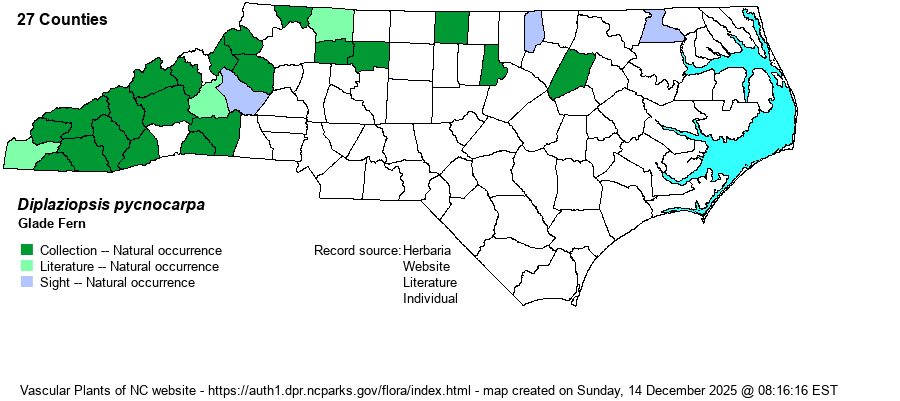| Author | (Sprengel) M.G. Price | |
| Distribution | Essentially throughout the Mountains; widely scattered eastward across the northern Piedmont and Coastal Plain, south only to Hertford, Nash, Durham, and Yadkin counties.
This is a Northeastern species, ranging from eastern Canada south to central NC, central AL, and rarely into LA. It is scarce in the southern Piedmont and the Coastal Plains. | |
| Abundance | Uncommon and local in the Mountains; rare and local in the northern Piedmont, and very rare into the northern Coastal Plain. | |
| Habitat | This is a species of cool, moist, high pH soil areas. It grows mostly in Rich Cove Forests and Basic Mesic Forests, but also is found in forested seepages, in rich bottomlands, and other very rich and moist shady and rocky forests. | |
| Phenology | Fruits from July to September. | |
| Identification | This is a scarce species, but should be easily identified, especially as it has recently been placed in its own genus. The stipe is green and about 2-4 inches long, with a long and narrowly ovate blade in general outline, one-pinnate only, reaching about 1.5-2 feet long and about 6 inches wide. There are 20-30 pairs of pinnae, often alternate, each unlobed (even at the base) and with entire (to somewhat wavy) margins, oblong to lanceolate in shape, pointed at the tips. Each pinna averages 2-3 inches long and 1/4-inch wide. The pinnae are slightly shorter toward the base of the blade, and are strongly shorter in length toward the apex of the blade. The only similar one-pinnate fern with such a large blade is the very common Christmas Fern (Polystichum acrostichoides), but that evergreen species has a basal lobe on each pinna, and the sori are rounded and limited to smaller pinnae near the blade summit. Homalosorus has numerous sori under each pinna, but they are linear and diagonal to the midrib. | |
| Taxonomic Comments | This species has switched genera several times in recent decades. For much of the past century, it was awkwardly placed in the genus Athyrium (others there have more strongly dissected blades), as A. pycnocarpon. It has been moved to Diplazium (i.e., D. pycnocarpon) as well. Some current references have settled on Homalosorus, but with a slight change in the specific epithet (H. pycnocarpos).
| |
| Other Common Name(s) | Narrowleaf Spleenwort, Narrowleaf Glade Fern | |
| State Rank | S3 | |
| Global Rank | G5 | |
| State Status | | |
| US Status | | |
| USACE-agcp | | |
| USACE-emp | | |

